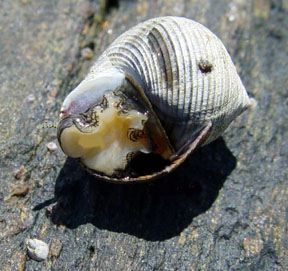 |
 |
|||||||||||||||
|
The common periwinkle has a thick shell that protects it from injury. It has many of the same adaptations as the other periwinkles. It can remain exposed, air-breathing, while the tide is out for several hours by sealing itself tightly to the rock surface with mucus. When experiencing temperature extremes the snail can create a double seal. First it will tightly seal itself to the rock with mucus. Once the mucus has hardened the snail will retract its foot and close its operculum (o-purr-cue-lum). The operculum is a structure attached to the foot of a snail, serving to close the aperture or opening when the animal withdraws into its shell. L. littorea reproduces using separate male and female individuals. Unlike the rough and smooth periwinkle, the common periwinkle does not brood its young and its development includes a planktonic stage. Once a female is fertilized she will spawn egg capsules directly into the sea. Egg capsules are about 1mm across and each capsule can contain up to nine eggs. Egg release is synchronized with spring tides. It can take up to six weeks for the larvae to settle out of the water column. |
||||||||||||||||
Did you know... |
||||||||||||||||
|
||||||||||||||||


